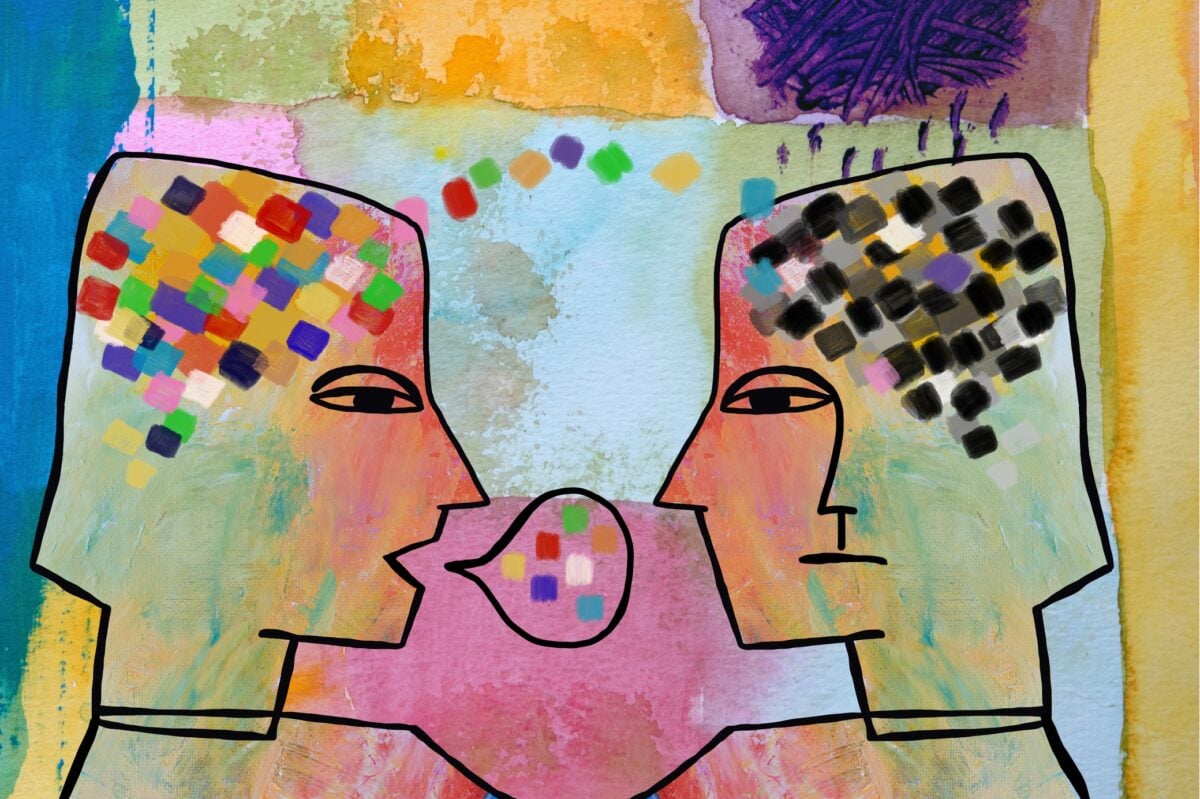

This therapist directory is offered in partnership with BetterHelp. If you sign up for therapy after clicking through from this site, HelpGuide will earn a commission. This helps us continue our nonprofit mission and continue to be there as a free mental health resource for everyone.
Need to talk to someone now? Find a crisis helpline
If you're a BetterHelp therapist with questions about your directory listing, please contact therapists@betterhelp.com
Emotion-focused therapy helps you explore emotions, uncover their meanings, and use them as drivers for change. Learn how EFT can be used to foster healthier relationships and mental health.

Emotion-focused therapy (EFT) is a type of therapy that helps you become more aware of your emotions, explore them, understand them better, and use them in a way that leads to a healthier life. EFT can strengthen your sense of self, make it easier to regulate intense emotions, and find meaning in emotions.
EFT follows the idea that your emotions can act as messengers for your needs and can motivate you to take action. For example, if you feel despair following a breakup, that deep sadness could be signaling a longing for closeness. If you feel furious about how a coworker treated you, that anger might be signaling that trust was broken or a boundary was overstepped. In either case, your emotions can also prep you to take action. Sadness can motivate you to seek new social support, while anger can motivate you to assert yourself and reinforce boundaries. These types of insights show up when you take the time to fully accept, experience, and understand your emotions.
EFT is considered a humanistic approach. It emphasizes the belief that people have an innate desire to seek growth, and can achieve it by exploring emotions that they typically avoid.
EFT is also rooted in attachment theory, which recognizes our fundamental need for connection with our loved ones. Feeling close to an attachment figure, such as a trusted friend or partner, builds a sense of safety and eases the nervous system. However, when an important bond feels threatened, that sense of safety is lost, and you experience hopelessness, distress, and have a hard time regulating your emotions. Early experiences with parents and caregivers in particular can shape how you view relationships later in life. For instance, if you were neglected as a child, you might go through life fearing that you can’t count on others or that you need to cling tightly to others for security.
EFT approaches mental health and relationships from this perspective. It aims to establish a “safe haven”—a space where you feel secure, accepted, and supported—so you can then explore your feelings and better navigate unhelpful emotions and relationship conflicts.
You might emerge from the process with a better understanding of where certain emotions are coming from and how they’ve guided you toward unhealthy behaviors. Or maybe you and your spouse begin to see how your go-to emotional reactions create negative patterns in your relationship. By being vulnerable and communicating your feelings, you can develop a deeper understanding of yourself and your dynamics with those who matter most to you.
EFT can be used as a therapy intervention for you as an individual, you and your partner, or you and your family.
This type of structured therapy aims to help you improve your internal sense of security, build a deeper sense of self-compassion, and form more secure attachments with others. In doing so, you also build resilience in the face of mental health issues, such as trauma, anxiety, and depression.
When used for couples, this therapeutic approach helps you and your partner notice and change the unhealthy patterns in your interactions. Maybe you struggle to fully trust your partner, and their emotional responses to your distrust involve lashing out and then withdrawing. This just fuels your fears. By adjusting the ways you express yourselves and respond to one another, you can build more secure bonds.
Families can also become stuck in unhealthy patterns. For instance, your parents might always seem to favor your brother over you, and their behavior leads you to resent your sibling. In EEFT, you might all strive to acknowledge those unspoken patterns, express yourselves, and find healthier ways to interact.
In EFT, the stages of intervention are stabilization (or de-escalation in couples or family therapy), restructuring, and consolidation.
The goal of stabilization is for you to develop a sense of safety and security with the therapist. This helps you to be more emotionally open during sessions and willing to work with uncomfortable feelings. This stage might involve identifying your sources of resilience (such as memories that bring up positive emotions) or practicing grounding exercises so you’re ready to explore your emotions without feeling overwhelmed.
The stabilization stage is also when you’ll work with your therapist to identify negative patterns and determine the goals of your treatment.
If you’re in couples or family therapy, the de-escalation stage fills in for stabilization. With the help of a therapist, you and your loved one take time to identify negative patterns you both contribute to. For instance, you might note that you withdraw from your partner when you feel criticized, or they get defensive when you offer advice.
In restructuring, you start to dig deeper and engage with uncomfortable emotional experiences. Here, you’ll start to work on accepting emotions and experiences and interpreting your feelings (or even your self and narratives) in different ways. For instance, you might consider that your episodes of intense anger are actually more about feeling helpless or misunderstood by a loved one.
Consolidation is about reinforcing new ways of feeling and thinking. Maybe you practice using your skills in real-life situations. This stage helps you feel more confident and capable in handling future issues.
A basic intervention technique that an EFT therapist will rely on during your sessions is called the EFT Tango. It involves five “moves” that a therapist uses to help you become more aware of your feelings and work through emotional experiences.
Mirroring present process. In this step, your therapist is interested in understanding what’s happening within you right now. “What’s happening as you talk about that argument you had?” “What are you feeling when you think about the difficult moment you had with your son?”
Affect assembly and deepening. The therapist then helps you further explore your emotions on a deeper level. You might spend more time talking about primary emotions (a feeling that’s a direct response to an event) and secondary emotions (which are reactions to primary emotions). If a friend yells at you, you might immediately feel shame and sadness. But then, you quickly move on to feeling angry that you were hurt. That anger is a secondary emotion. Once you can identify and understand the emotions, you can use them to motivate change.
Choreographing engaged encounters. Much like exposure therapy, this step offers a safe environment in which you can practice dealing with uncomfortable emotions that you’d otherwise avoid. For instance, in individual sessions, you might reimagine a traumatic event occurring and practice ways of soothing a younger, more vulnerable version of yourself. In couples therapy, you might practice expressing your primary emotions and reactions to your partner.
Processing the encounter. Here, your therapist might ask you to take a step back and reflect on the emotional encounter you just had. What did it feel like to open up and deal with those emotions? “How did it feel to self-soothe?” or “How did it feel to tell your partner about your fears, rather than attack?”
Integrating and validating. The therapist might summarize the entire process and point toward the progress you’ve made. This might simply involve acknowledging or celebrating what occurred in the previous steps. For instance, the ability to identify the fear beneath your anger and then self-soothe is worth celebrating. Or maybe you and your partner broke free from a problematic cycle by expressing your emotional needs, rather than lashing out.
EFT can be a useful tool for managing difficult emotions and fostering better relationships. Ultimately, it has the potential to enhance your overall well-being.
Emotional regulation. EFT can equip you with the skills to recognize, understand, and process your emotions more effectively. As you develop those skills, you become better at managing emotions that often seem overwhelming or that steer you toward unhealthy behaviors. For instance, you can begin to address feelings of despair without relying on self-medicating habits.
Improved relationship satisfaction. In couples and family sessions, EFT encourages open communication and empathy. By the end of your sessions, you might have an easier time understanding one another’s needs, dealing with conflicts, and recognizing patterns in your dynamic. Studies show that EFT can even help couples dealing with “significant” relationship distress.
Better overall psychological well-being. EFT can have a wide range of benefits for your mental health. For instance, research shows that it can help with depression, trauma, and anxiety. There’s some evidence that it might also be effective in treating social anxiety disorder, reducing self-criticism, and increasing self-compassion.
For individuals, couples, and families, EFT can offer a path to hope and healing in challenging times. However, it isn’t a one-size-fits-all approach to therapy. It has several limitations to consider.
First, the approach isn’t suitable for everyone. For instance, EFT might not be effective if a person has a limited capacity to connect with their emotions. It can also be a difficult process for people who are easily overwhelmed by their emotions or struggle with seeing another person’s perspective.
The current approach to EFT might not suit people with conditions like autism or severe personality disorders. It’s possible that the steps could be adjusted to accommodate more people. For instance, a different approach might be helpful for people with avoidant personality disorder or borderline personality disorder.
Second, EFT relies heavily on the individual therapist’s skills. Because it’s a structured process and can involve intense emotional engagement, the therapist needs to be well-trained in the steps.
Finally, EFT is used as a short-term intervention, and depending on your needs, it tends to involve eight to 20 sessions. This treatment range might be too long for some people, but not long enough for others.
Before looking for an EFT therapist, it might be helpful to ask yourself the following questions.
Are you willing to engage with uncomfortable emotions and be vulnerable? You’ll need to be open to working with and expressing emotions that you typically avoid.
Is everyone involved ready to take part? Getting everyone else—whether it’s a spouse, parents, or children—onboard with therapy is also crucial to the process.
Is domestic violence part of the dynamic? If so, you might consider other interventions or resources that can more immediately get you out of harm’s way.
Does the length of the process work for you? It might not be the right approach for someone or a couple looking for a longer therapy journey.
The International Centre for Excellence in Emotionally Focused Therapy (ICEEFT) offers a directory to find nearby therapists who use this particular approach. You can search for therapists who specialize in individual, couples, or family EFT, as well as search by faith, language, focus area, and other criteria. The listing includes therapists who have foundational training, additional training, or certification. You can also find people who are supervisors, meaning they have enough training that they’re able to mentor other EFT therapists.
When selecting an EFT therapist, consider asking them some of the following questions to ensure they’re a good fit for you:
Once you find an EFT therapist to guide you, you can begin a journey toward healthier relationships with others and a deeper relationship with your own emotions.
Last updated or reviewed on September 5, 2025Millions of readers rely on HelpGuide.org for free, evidence-based resources to understand and navigate mental health challenges. Please donate today to help us save, support, and change lives.
Donate to HelpGuide.org today